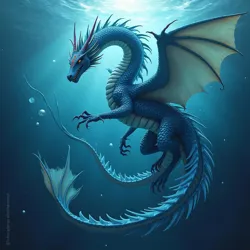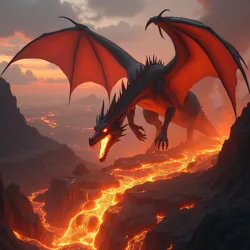Elemental Dragons of Dracona

Dracona planet dominated by elemental dragons, keystone species embodying fire water earth and air.
Dracona
Elemental Dragons
4
['fire', 'water', 'earth', 'air']
keystone species
Elemental Dragons of Dracona, sometimes referred to as Draconian Elementals or Essence Dragons, are the dominant and keystone species of the terrestrial planet Dracona. These extraordinary creatures are not merely animal inhabitants but are deeply interwoven with the planet's fundamental elemental forces—fire, water, earth, and air—each dragon species embodying and regulating its respective element within Dracona's diverse biomes. Their existence is central to the planet's unique character, shaping its landscapes, influencing its climate, and defining its vibrant ecosystems. The term "elemental dragon" distinguishes them from mythological dragons found in Terran folklore, highlighting their biological nature and integral role in the planetary ecosystem.
Characteristics of Elemental Dragons
Elemental dragons are characterized by a suite of physiological and behavioral adaptations that allow them to not only survive but thrive in the extreme conditions of Dracona's elemental biomes. These are not uniform creatures; rather, they exhibit a remarkable diversity in form, size, and abilities, each type uniquely molded by the selective pressures of its environment. However, certain common traits unite them as a distinct group of lifeforms.
 Serpentine water dragons adapted to deep sea pressure, ruling oceanic biomes and generating whirlpools.
Serpentine water dragons adapted to deep sea pressure, ruling oceanic biomes and generating whirlpools.General Attributes
Across all elemental dragon species, a few key attributes are consistently observed:
- Elemental Affinity: Each dragon species exhibits a profound connection to one of the four classical elements: fire, water, earth, or air. This affinity is not merely symbolic; it is deeply physiological, manifesting in their anatomy, metabolism, and behavior. They can often manipulate or draw sustenance directly from their element, and their presence influences the elemental balance of their biome.
- Draconian Morphology: While diverse, their body plans share common features, often including reptilian or serpentine body forms, scaled hides (though the composition and texture vary greatly), powerful limbs or fins adapted for their environment, and sensory organs highly attuned to their element. For more detailed information, see Draconian Morphology.
- Apex Predation or Keystone Roles: Elemental dragons typically occupy apex predator positions within their respective biomes, or, more broadly, function as keystone species. Their actions regulate prey populations, shape habitat structure, and influence nutrient cycles. Their removal would have cascading effects throughout their ecosystems.
- Complex Behaviors: Far from being simple beasts, Draconian dragons display intricate social structures, territorial behaviors, communication methods, and even problem-solving abilities. Their intelligence and behavioral flexibility are essential for navigating the dynamic and often harsh conditions of Dracona.
- Extended Lifespans: Compared to many other lifeforms on Dracona, elemental dragons are remarkably long-lived. Lifespans vary by species and size, but many can survive for centuries, and some of the largest individuals are theorized to live for millennia. This longevity allows them to accumulate ecological knowledge and exert long-term influence on their environments.
Ignis Dragons
Ignis Dragons are the embodiments of fire, inhabiting the volcanic Ignis Fields of Dracona. They are masters of heat and molten rock, their very presence intertwined with the planet's volcanic activity.
- Physical Characteristics: Ignis Dragons are typically massive, with robust, four-legged bodies and thick, overlapping scales that radiate intense heat, often shimmering with an orange or red glow. Their scales are composed of heat-resistant minerals and are constantly renewed. They possess powerful jaws lined with teeth capable of crushing volcanic rock and sharp claws for navigating treacherous terrain. Many Ignis Dragons have crests or horns along their heads and backs, which can glow brightly when they are agitated or displaying dominance.
- Elemental Abilities: These dragons can breathe jets of superheated plasma, ignite the very air around them, and even manipulate lava flows to a limited extent. They possess specialized organs that allow them to absorb geothermal energy directly from vents and lava pools, supplementing their diet. Their blood is exceptionally hot, allowing them to withstand extreme internal and external temperatures.
- Behavior and Ecology: Ignis Dragons are fiercely territorial and solitary creatures, primarily interacting during mating season or in violent territorial disputes. Their roars are often accompanied by bursts of flame and tremors in the ground. They are apex predators, feeding on heat-resistant fauna within the Ignis Fields, but also derive significant sustenance from geothermal energy. Their burrowing and movements help to regulate lava flows and prevent volcanic pressure buildup, playing a critical role in the geological stability of their biome. Shed scales are a valuable resource, used by other creatures for heat protection.
Aquamarina Dragons
Aquamarina Dragons rule the Aquamarina Depths, the vast oceanic biomes of Dracona. They are creatures of the deep, adapted to the crushing pressures and frigid temperatures of the abyssal zones, as well as the sunlit surface waters.
- Physical Characteristics: Aquamarina Dragons are typically serpentine and elongated, built for agile movement through water. Their bodies are streamlined, and they possess smooth, scale-like skin that can range in color from deep blues and greens in the deep sea to iridescent silvers and blues in shallower waters. They have fins or paddle-like limbs for propulsion and maneuverability. Many species exhibit bioluminescent patterns on their skin, used for communication, camouflage, and attracting prey in the dark depths. They have large, sensitive eyes adapted for low-light conditions and specialized sensory organs to detect pressure changes and electrical signals in the water.
- Elemental Abilities: Aquamarina Dragons can manipulate water currents, generate powerful whirlpools, and even create localized pockets of supercooled water. They breathe through gills and possess specialized osmoregulatory systems to manage the salinity of their environment. Some species can survive for extended periods in both saltwater and freshwater environments.
- Behavior and Ecology: Social behavior varies greatly among Aquamarina Dragons. Some are solitary hunters, while others form loose aggregations around hydrothermal vents or migrate in groups along ocean currents. They are apex predators, feeding on a wide variety of marine life, from fish and cephalopods to marine reptiles and even smaller Aquamarina Dragons. Their presence regulates marine populations and contributes to nutrient cycling in the oceans. Bioluminescent secretions from some species have unique chemical properties and attract smaller organisms, forming the base of localized food chains.
Terran Dragons
Terran Dragons are the lords of the Terran Spires, the mountainous and terrestrial highlands of Dracona. They are creatures of earth and stone, their forms reflecting the rugged and mineral-rich environment they inhabit.
- Physical Characteristics: Terran Dragons are characterized by their sturdy, heavily armored bodies. Their scales are thick, plate-like, and composed of mineralized materials, often reflecting the geology of their specific territories – granite-like greys, sandstone browns, or even metallic hues where mineral deposits are rich. They have powerful, clawed limbs for climbing and digging, and strong, blunt snouts for moving earth and rocks. Many have bony ridges or spikes for defense and display.
- Elemental Abilities: Terran Dragons possess an affinity for earth and stone. They can manipulate earth and rock to create tunnels, landslides, or defensive barriers. They have a remarkable ability to sense mineral deposits and geological formations beneath the surface. They are also highly resistant to physical damage and environmental extremes such as temperature fluctuations and low atmospheric pressure.
- Behavior and Ecology: Terran Dragons are generally territorial, but often live in small family groups or clans, particularly in resource-scarce regions. They communicate through body postures, ground vibrations, and scent markings. They are primarily herbivores, feeding on mineral-rich vegetation, mosses, lichens, and even directly consuming soil and rocks to extract essential minerals. Their burrowing and digging activities aerate the soil and contribute to erosion and mineral dispersal, shaping the landscape of the Terran Spires. The mineral content of their scales and bones varies based on their territory, making them living geological records.
Ventus Dragons
Ventus Dragons reign supreme in the Ventus Expanse, the aerial biome of Dracona. They are masters of the skies, embodying the element of air and the power of the wind.
- Physical Characteristics: Ventus Dragons are the most ethereal and graceful of the elemental dragons. They are lightweight and aerodynamically built, with expansive, membranous wings that allow for effortless soaring and complex aerial maneuvers. Their bodies are slender and covered in smooth, overlapping feathers rather than scales, often in pale blues, whites, and greys, providing excellent camouflage against the sky. They have keen eyesight and highly developed sensory organs to detect subtle shifts in air currents and atmospheric pressure. Some species possess specialized air sacs to enhance buoyancy and control.
- Elemental Abilities: Ventus Dragons can generate powerful gusts of wind, create localized storms, and even manipulate air pressure to a degree. They are incredibly sensitive to air currents, using them for both navigation and hunting. Some species can draw energy from atmospheric electrical charges, supplementing their metabolic needs.
- Behavior and Ecology: Ventus Dragons are the most social of the Draconian dragons, often congregating in large flocks, especially during migration or breeding seasons. They communicate through aerial acrobatics, vocalizations (often high-pitched whistles and cries), and feather displays. They are primarily carnivorous, preying on airborne fauna, smaller flying creatures, and even descending to hunt in other biomes occasionally. Their flight patterns and wing movements influence wind currents and cloud formation, playing a role in regulating atmospheric dynamics. Shed feathers are prized for their lightness and aerodynamic properties, used by other Draconian lifeforms for gliding and insulation.
Elemental Dragon Biomes
The elemental dragons are not just inhabitants of their respective biomes; they are integral to the very definition and maintenance of these environments. The biomes themselves are dynamic zones of elemental energy, each characterized by extreme conditions that have shaped the dragons and other lifeforms adapted to them.
 Massive fire dragons with heat radiating scales, inhabiting volcanic regions and manipulating lava flows.
Massive fire dragons with heat radiating scales, inhabiting volcanic regions and manipulating lava flows.Ignis Fields: The Realm of Fire
The Ignis Fields are the fiery heart of Dracona, a vast equatorial belt of volcanic activity. Dominated by towering volcanoes like the Ignis Peaks, lava flows, geothermal vents, and obsidian plains, this biome is a crucible of intense heat and geological dynamism. The atmosphere is thick with volcanic gases, and the ground radiates thermal energy. Life here is adapted to extreme thermophilic conditions, with heat-resistant flora and fauna forming the base of the food web, culminating in the apex predator, the Ignis Dragon.
Aquamarina Depths: The Domain of Water
The Aquamarina Depths encompass the vast polar oceans of Dracona, plunging into deep abyssal trenches. These realms are characterized by extreme pressure, frigid temperatures in the depths, and varying salinity. Sunlight penetration is limited, leading to distinct life zones from the sunlit surface to the perpetually dark abyss. Hydrothermal vents provide oases of warmth and mineral richness in the deep, supporting unique ecosystems. The Aquamarina Dragon is the dominant lifeform, adapted to these diverse aquatic conditions.
Terran Spires: The Stronghold of Earth
The Terran Spires are the mountainous highlands of Dracona, regions of towering rock formations, deep canyons, and mineral deposits. Shaped by millennia of tectonic activity and erosion, the landscape is rugged and varied. The climate is drier and more temperate than the extreme biomes, but altitude, thin atmosphere, and harsh weather still present challenges. Sparse but resilient vegetation thrives on mineral-rich soils, supporting burrowing and rock-dwelling fauna, and the powerful Terran Dragon.
Ventus Expanse: The Kingdom of Air
The Ventus Expanse is the aerial biome, encompassing the upper atmosphere and high plateaus of Dracona. Perpetual winds, jet streams, and atmospheric turbulence define this realm. Less tangible than other biomes, it is vital for Dracona's global climate and weather patterns. Specialized airborne microorganisms and floating vegetation exist, but the Ventus Dragon, master of the skies, is the undisputed ruler of this airy kingdom.
Draconic Ecology and Inter-species Dynamics
Elemental dragons are not isolated monarchs of their domains but exist within complex ecological webs, interacting with a myriad of other Draconian lifeforms. Their roles extend beyond apex predation to encompass ecosystem engineering and even elemental regulation.
 Graceful air dragons with feathered wings, soaring in aerial biomes and controlling wind currents.
Graceful air dragons with feathered wings, soaring in aerial biomes and controlling wind currents.Interactions with Flora and Fauna
- Ignis Fields: Ignis Dragons prey on heat-resistant insects, lava-dwelling reptiles, and thermophilic avian species found in the Ignis Fields. They indirectly support thermophilic bacteria and fungi by regulating geothermal activity and distributing heat through their movements. Smaller, fire-resistant creatures often seek shelter in the vicinity of Ignis Dragon territories for protection from larger predators and harsh conditions, creating a form of commensalism.
- Aquamarina Depths: Aquamarina Dragons feed on a vast range of marine life, from plankton-eating filter feeders to large cephalopods and other marine predators. They regulate populations of fish, crustaceans, and other marine reptiles, maintaining balance within the food web. Their bioluminescent secretions attract smaller organisms, creating localized food sources for various species. The movement of Aquamarina Dragons also contributes to the mixing of water layers and nutrient distribution throughout the ocean.
- Terran Spires: Terran Dragons, as herbivores, are primary consumers, feeding on mineral-rich vegetation and directly consuming earth and rocks. They are preyed upon by some aerial predators from the Ventus Expanse, and their carcasses provide nutrients to the soil. Their burrowing activities create habitats for smaller burrowing creatures and aerate the soil, facilitating plant growth. The minerals they ingest and excrete are redistributed across the landscape, influencing soil composition and nutrient cycles.
- Ventus Expanse: Ventus Dragons prey on airborne insects, flying reptiles, and smaller avian species adapted to the high altitudes and strong winds of the Ventus Expanse. They may also descend to hunt in adjacent biomes, creating ecological links between aerial and terrestrial or aquatic ecosystems. Their presence influences atmospheric dynamics, affecting cloud formation and wind patterns, which in turn impact weather across Dracona. Shed feathers provide insulation and aerodynamic materials for other aerial creatures and even some terrestrial species.
Interspecies Dragon Interactions
While primarily territorial within their own species, elemental dragons also exhibit limited but significant interactions between different elemental types. These interactions are most common in ecotones, transitional zones between biomes where elemental influences intermix.
- Territorial Overlap: In border regions between biomes, for instance, where volcanic foothills transition into rocky highlands, Ignis Dragon territories may overlap with Terran Dragon ranges. These encounters are usually competitive, with dragons of different elements vying for resources or dominance. However, they rarely escalate to direct conflict, often resolved through displays of elemental power – fire roars against earth tremors, for example.
- Predation and Scavenging: Larger Ventus Dragons may occasionally prey on smaller, juvenile dragons of other types, particularly if they venture too far into aerial territories. Conversely, Ignis Dragons, due to their immense size and heat aura, are rarely preyed upon by other dragon types, but their carcasses may be scavenged by Terran or Ventus Dragons if opportunity arises. Aquamarina Dragons, especially in shallower waters near coastal regions, may sometimes encounter Terran or even Ventus Dragons, but direct interactions are less common due to the distinct nature of their habitats.
- Hybridization (Rare): In ecotones, there is theoretical potential for hybridization between closely related dragon species from adjacent biomes. However, such events are believed to be extremely rare, and hybrid offspring are often less well-adapted to any specific biome, making their survival and reproduction unlikely. Genetic compatibility and behavioral isolation likely minimize hybridization.
Elemental Regulation
Perhaps the most profound ecological role of elemental dragons is their contribution to the regulation of Dracona's elemental balance. Each dragon species, through its physiology, behavior, and interactions with its environment, acts as a regulator of its respective element.
- Ignis Dragons and Volcanic Activity: By burrowing, moving, and consuming geothermal energy, Ignis Dragons help to manage lava flows and prevent excessive pressure buildup in volcanic systems. Their presence is crucial for maintaining a healthy level of volcanic activity in the Ignis Fields, preventing both catastrophic eruptions and geological quiescence.
- Aquamarina Dragons and Ocean Dynamics: Aquamarina Dragons contribute to ocean circulation, nutrient mixing, and the distribution of marine life through their movements and feeding habits. They help regulate populations of marine organisms, preventing imbalances in the oceanic ecosystem.
- Terran Dragons and Mineral Cycles: Terran Dragons play a role in erosion, soil aeration, and mineral dispersal through their burrowing and feeding activities. They help to break down rocks, enrich soils, and distribute minerals across the Terran Spires, influencing plant growth and nutrient availability.
- Ventus Dragons and Atmospheric Dynamics: Ventus Dragons influence wind patterns, cloud formation, and atmospheric circulation through their flight and wing movements. They contribute to the planet's weather systems and help to regulate atmospheric composition and temperature distribution.
In essence, the elemental dragons are not just inhabitants of Dracona; they are active participants in shaping and maintaining the planet's unique elemental character. Their presence is so deeply integrated into Dracona's ecosystems that the planet itself could almost be considered a living entity, with the dragons acting as vital organs within a planetary-scale organism, regulating the flow of fire, water, earth, and air.
Dracona in the Cosmos and the Obsidian Eye Expedition
The extraordinary nature of Dracona, with its vibrant elemental biomes and dominant dragon species, has attracted attention from beyond its star system. The Explorers of the Obsidian Eye, a multi-species expeditionary group, have recently discovered and begun to study Dracona, initiating first contact and observing the planet and its dragons with a commitment to non-interference and ethical exploration. Their flagship, the Umbral Voyager, remains in orbit, conducting ongoing research and observation.
The Obsidian Eye explorers are particularly fascinated by the elemental dragons, recognizing their unique biological adaptations, complex behaviors, and crucial ecological roles. Their research focuses on non-invasive observation, utilizing remote sensing technologies and unmanned probes to study dragon populations, communication methods, and ecosystem dynamics. Xenolinguists are working to decipher dragon communication signals, while environmental specialists are studying the delicate balance of Dracona's elemental biomes.
The discovery of Dracona and its elemental dragons represents a significant milestone in extraterrestrial exploration, presenting unprecedented scientific opportunities and raising profound ethical considerations about interspecies contact and planetary stewardship. The ongoing research by the Explorers of the Obsidian Eye promises to deepen our understanding of elemental dragons and their extraordinary world, while also prompting reflection on our place in the wider cosmos and our responsibilities towards other life-bearing planets.